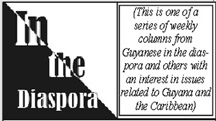By Jamila Ali
Jamila Ali, a friend of the Caribbean, lives with her family in Lahore, Pakistan.
A shorter version of this article appeared on March 28, inScroll.in, an independent blog that discusses the most important political and cultural stories that are shaping contemporary India.

We do not have a television. So allah ki shukhar we have been spared being traumatized by the looping repetition of wailing relatives, the attribution of blame, and most ghastly of all, the appropriation of pain for national gain. Social media has calmly informed us of where we could donate blood, and which hospital had sufficient blood. I am grateful for both these small mercies as this bloody Easter, 2016, draws to a close.
My family and friends were at a different park earlier this evening – Lawrence Gardens – where a group of us, 5 women and one daughter, played cricket. We said it was to celebrate the victories of the Pakistani women’s team, but really we were there just to run and laugh and stretch our limbs. Another group of our women friends had ridden bicycles together through the streets of Gulberg in the morning. Small changes and shifts, we thought.
Hundreds of families were at the park as usual on a Sunday, and perhaps more, as it was Easter. I was acutely conscious all day that at the older end of the city, thousands of pilgrims, men and women, had gathered for the second day of the Madhu Lal Hussain Urs festival, which I had attended the previous night, and which has been celebrated for over 400 years in the city.
Pakistan is the land from where the most profound sufi music and qawaali singing in the world emerged; and, the landscape is dotted with shrines of long-gone pirs or saints, whose poetry and words continue to inflame or feed the souls of people. Shah Hussein was a poet of the 16th century Punjabi countryside; it is told he pioneered the kafi style of poem. He was born to a weaver’s family (like the equally renowned poet, Kabir, from Benares). He loved a Brahman boy called Madho Lal, and their names and stories and followers have been intertwined since. Their tombs lie adjacent to each other, and is where, annually, people throng to light diyas and dance. The mood at the mela is not light, but fervent, passionate, and very redolent of intertwined fates of people and spirits. This is a story of the old Pakistan, long before the state and modernized theocratic religion began to impose its deadly imprint on the populace.
Altogether, the city felt alive today. The only twinge of regret in my mind was that back in February 2015, coordinated blasts in Christian churches on the outskirts of Lahore had led to our family’s unspoken decision to not attend church while in Pakistan.
We returned home from the park, and were on the terrace with friends when our daughter rushed over to tell us there had been a bomb blast in the city. A friend then stated that he had already heard this, though he had not mentioned it previously. I thought this strange, even while we descended into an uneven silence. Another friend offered, “I don’t even feel it. That’s how desensitized we are.” A third tried to restore our previous tone and topic, desperate that we not linger on a tragic note.
I allowed the sadness to settle. I feel a tremendous relief that the Madho Lal – Hussain mela was not targeted. That would have ripped a hole in the city and, if you like, Punjabi secularism which could not ever, ever be repaired. That would have ripped holes in thousands of people who poured into the city to connect their lives with the music and the saints. I feel very strange I am picking and choosing…
After our friends left, I settled down to social media. Messages from around the world inquiring about our safety.
Tomorrow we will steel ourselves for the new security measures which will be thrown haphazardly, encircling and stalling the streets, catching harmless motorists and those who look like they don’t belong.




